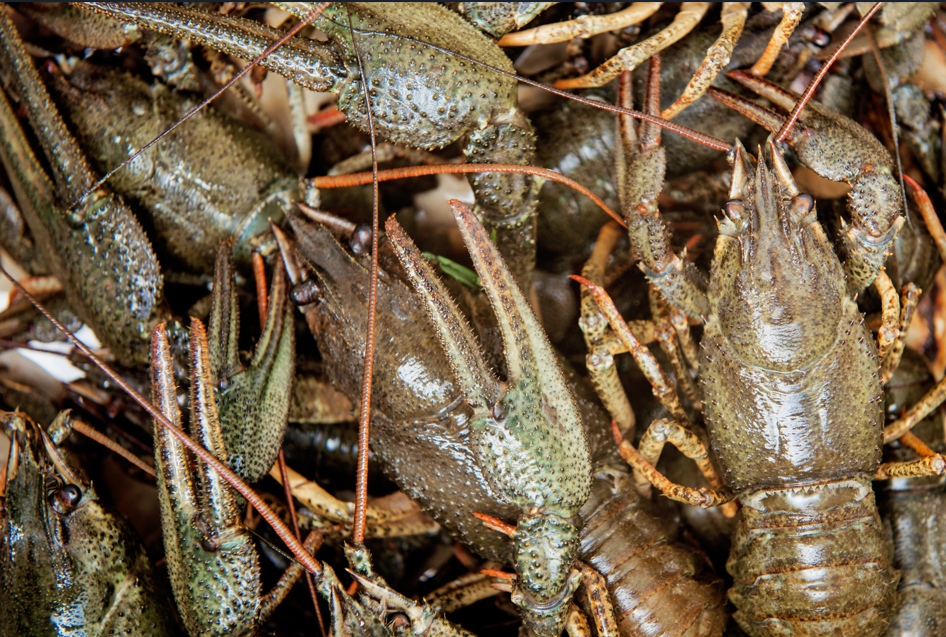Read More: Culinary History of Crawfish (Crayfish, Crawdads)
Ancient Ancestry and Early Interactions
The evolutionary history of crawfish dates back hundreds of millions of years, with fossil evidence suggesting their ancestors existed in the Permian period. These early crustaceans inhabited shallow seas and freshwater environments, gradually adapting to the diverse aquatic ecosystems we see today.
For humans, the interaction with crawfish likely began with the earliest settlements near freshwater sources. Archaeological evidence from around the world, including North America, Europe, and Asia, shows that indigenous peoples have consumed crawfish for thousands of years.
- North America: Native American tribes, particularly those in the Mississippi River Delta and along the Gulf Coast, relied on crawfish as a readily available food source. They developed various methods for catching them, including traps, nets, and even hand-catching. Crawfish were often roasted, boiled, or dried for preservation. The Houma tribe of Louisiana, for example, has a deep cultural connection to crawfish, with the animal serving as a clan symbol and appearing in traditional stories and rituals.
- Europe: Evidence of crawfish consumption in Europe dates back to the Paleolithic era. Archaeological digs have unearthed crawfish remains in ancient settlements, suggesting they were a part of the diet of early Europeans. During the Middle Ages, crawfish were considered a delicacy among the nobility and were often featured in elaborate feasts. They were also valued for their perceived medicinal properties.
- Asia: Crawfish are also native to parts of Asia, and their consumption has a long history in countries like China. They are a popular ingredient in various regional cuisines and are often prepared with spicy sauces and seasonings.
The Rise of Crawfish in Louisiana
While crawfish were consumed in various parts of the world, Louisiana is undeniably the epicenter of crawfish culture today. This unique culinary tradition has its roots in a complex interplay of historical factors:
- Acadian (Cajun) Influence: In the mid-18th century, Acadian exiles from Canada, known as Cajuns, settled in the swamps and bayous of southern Louisiana. They brought with them a resourceful culinary tradition that emphasized using locally available ingredients. Crawfish, abundant in the region’s waterways, became a staple food for the Cajuns.
- Early Crawfish Fishing: Initially, crawfish were primarily harvested for personal consumption and local trade. The industry remained relatively small-scale for many years.
- The Great Depression and Rice Farming: The Great Depression of the 1930s had a significant impact on the Louisiana crawfish industry. As rice prices plummeted, farmers began to flood their fields during the off-season, creating ideal habitats for crawfish. This practice, known as rice-field aquaculture, led to a dramatic increase in crawfish production.
- The “Crawfish Boil” Emerges: The tradition of the crawfish boil, a communal feast featuring boiled crawfish, potatoes, corn, and spices, gradually developed over time. It became a central part of Cajun culture, a celebration of food, family, and community.
- Post-World War II Boom: After World War II, improvements in transportation and refrigeration allowed Louisiana crawfish to reach a wider market. The industry began to grow rapidly, with commercial crawfish farms emerging alongside traditional wild harvesting.
- The Breaux Bridge Crawfish Festival: In 1960, Breaux Bridge, Louisiana, a town with a long history of crawfish harvesting, was officially designated the “Crawfish Capital of the World.” The annual Breaux Bridge Crawfish Festival, first held that year, became a major event, attracting thousands of visitors and solidifying Louisiana’s reputation as the heart of crawfish culture.
Crawfish Beyond Louisiana
While Louisiana remains the dominant force in crawfish production and consumption, the popularity of these crustaceans has spread far beyond the state’s borders.
- National and International Expansion: Crawfish are now enjoyed throughout the United States, with growing popularity in regions with significant Cajun or Creole populations. They are also exported to various countries around the world, particularly in Europe and Asia.
- Crawfish Farming Around the Globe: Crawfish aquaculture has expanded significantly, with farms now operating in various countries, including China, Spain, and Egypt. This has made crawfish more accessible and affordable to a wider consumer base.
- Culinary Adaptations: While the Louisiana-style crawfish boil remains a classic, chefs and home cooks around the world have embraced crawfish in various culinary applications. They appear in dishes like étouffée, bisque, paella, pasta dishes, and even sushi.
- Crayfish plague (Aphanomyces astaci) in Europe: A significant factor that has affected the European Crayfish populations since being introduced in the 1860s with imported North American species.
Sustainability and the Future of Crawfish
The future of the crawfish industry faces both opportunities and challenges.
- Sustainability Concerns: Overfishing and habitat loss pose threats to wild crawfish populations in some areas. Sustainable harvesting practices and responsible aquaculture are crucial for ensuring the long-term viability of the industry.
- Climate Change: Changes in water temperature, salinity, and rainfall patterns can impact crawfish populations and aquaculture production. Adapting to these changes will be essential for the industry’s resilience.
- Invasive Species: The introduction of non-native crawfish species can disrupt local ecosystems and compete with native populations. Preventing the spread of invasive species is a key conservation priority.
- Continued Demand: Despite these challenges, the global demand for crawfish is expected to continue growing. This presents opportunities for innovation in aquaculture, processing, and marketing.
Conclusion
The history of crawfish is a testament to the enduring relationship between humans and the natural world. From their ancient origins as a sustenance food source to their modern-day status as a culinary delicacy and cultural symbol, crawfish have played a significant role in the lives of people around the globe. Their story is one of adaptation, resilience, and the power of food to connect us to our past, our communities, and the environment. As we continue to enjoy these flavorful crustaceans, it’s important to appreciate their long and fascinating journey and to support sustainable practices that ensure their continued presence for generations to come.


Share
Click on the icons below to share "Title of the item to share"